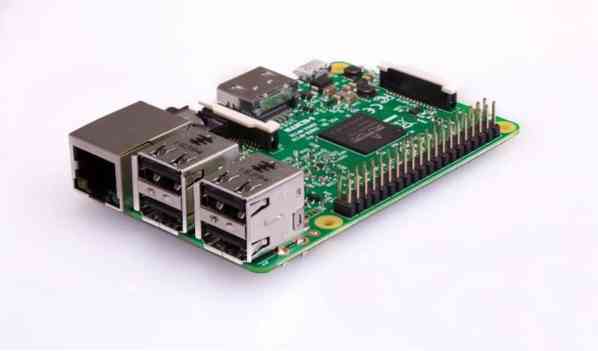Raspberry Pi 3 also consumes very low power. You can even keep a Raspberry Pi 3 running for a long time with an ordinary Mobile Power Bank that you use every day to charge your Android phone. Isn't that amazing? You can say good-bye to your expensive UPS and keep your Raspberry Pi microcomputer running as long as you want in case of power failure with very low cost in your home.
Raspberry Pi 3 Model B and Raspberry Pi 3 Model B+ is the last two revisions of Raspberry Pi 3 single board computer.

Fig: Raspberry Pi 3 Model B (picture from https://www.raspberrypi.org/products/raspberry-pi-3-model-b/)
In this article, I will talk about Raspberry Pi 3 Model B and Raspberry Pi 3 Model B+ and its power requirements. So let's get started.
Hardware Specification of Raspberry Pi 3 Model B:
Raspberry Pi 3 Model B was released in February 2016. It has
- 64 Bit Quad Core 1.2 GHz Broadcom BCM2837 CPU. The CPU architecture is ARMv8.
- 1 GB of RAM Soldered on Board.
- On Board Wireless LAN.
- On Board Bluetooth Low Energy 4.1 (or BLE 4.1).
- 10/100-Base-T Ethernet Port (RJ-45).
- 4 USB 2.0 Ports.
- 40 GPIO Pins for connecting and controlling other electronic devices and different Raspberry Pi modules, such as Raspberry Pi Camera module.
- 4 Pole Stereo Audio and Video output via 3.5mm connector.
- HDMI port for Audio and Video output.
- micro USB port as power supply.
- An On Board micro SD Card Slot.
Difference Between Raspberry Pi 3 Model B and Raspberry Pi 3 Model B+:
In March 14, 2018, the Pi Day 2018, Raspberry Pi 3 Model B+ was release with slight hardware improvements.
Raspberry Pi 3 Model B+ has a 1.4 GHz Quad Core Cortex-A53 (ARMv8 architecture) CPU, which is slightly faster than the CPU of the Raspberry Pi 3 Model B.
Raspberry Pi 3 Model B+ has Bluetooth Low Energy 4.2. Raspberry Pi 3 Model B has Bluetooth Low Energy 4.1.
Raspberry Pi 3 Model B+ can boot from the USB 2.0 storage devices such as USB thumb drives connected to the USB 2.0 ports by default. Boot from USB 2.0 devices connected to the USB 2.0 ports of Raspberry Pi 3 Model B is disabled by default. You will have to manually enable it. But both Raspberry Pi 3 Model B and Raspberry Pi 3 Model B+ can boot from micro SD card connected to the micro SD card slot.
Raspberry Pi 3 Model B+ has support for 2.4 GHz and 5 GHz WiFi channels but Raspberry Pi 3 Model B does not.
Raspberry Pi 3 Model B+ has support for PoE over the Ethernet port (RJ-45), which Raspberry Pi 3 Model B does not.
Raspberry Pi 3 Model B and Raspberry Pi 3 Model B+ has 10/100 Mbps Ethernet port (RJ-45) on board. But if you want to connect a Gigabit Ethernet to your Raspberry Pi, you can on Raspberry Pi 3 Model B+ using a USB 2.0 Ethernet LAN card. But the speed will be limited to 300Mbps. On Raspberry Pi 3 Model B, you can't do such thing.
That's basically the main difference between Raspberry Pi 3 Model B and Raspberry Pi 3 Model B+. I have Raspberry Pi 3 Model B, so that's what I will be using in the upcoming articles. But it should be applicable to Raspberry Pi 3 Model B+ as well without any changes.
Power Requirements of Raspberry Pi 3 Model B and Raspberry Pi 3 Model B+:
You need a 5V, 2.5 Amp micro USB power adapter for powering your Raspberry Pi 3 Model B and Raspberry Pi 3 Model B+. You can use many of the good Android phone charger to power on your Raspberry Pi 3 Model B and Raspberry Pi 3 Model B+ device. You can also use a regular power bank that you use on your phone to power on your Raspberry Pi 3 Model B and Raspberry Pi 3 Model B+.
Any Android phone charger and power bank should work. But I recommend you don't use bad or cheap chargers. The cables in those chargers are not good. So, voltage drops in the cable, leaving less than 5.0 V for your Raspberry Pi 3 Model B and Raspberry Pi 3 Model B+ microcomputer. In that case, when you power on your Raspberry Pi 3 Model B and Raspberry Pi 3 Model B+, it should boot, but you will see a small lighting symbol on the screen. The lighting symbol means, your Raspberry Pi 3 Model B and Raspberry Pi 3 Model B+ is running on low power mode. If you connect power hungry USB devices to your raspberry pi, it may reset on its own as it does not have enough power to run properly.
Power Consumption of Raspberry Pi 3 Model B and Raspberry Pi 3 Model B+:
Raspberry Pi 3 Model B consumes less power than Raspberry Pi 3 Model B+.
Raspberry Pi 3 Model B consumes about 260 mA of current at 5.0 V (which is about 1.3-1.4 Watt) when no USB devices are connected to it and it's in idle state.
Raspberry Pi 3 Model B+ consumes about 400 mA of current at 5.0 V (which is about 1.9-2.1 Watt) when no USB devices are connected to it and it's in idle state.
If you add more accessories to your Raspberry Pi 3 Model B and Raspberry Pi 3 B+ or if it's not idle (working), then the power consumption will increase.
Saving Power on Raspberry Pi:
If you want to save power, you should of course connect less accessories to your Raspberry Pi and disable the features that you don't need.
So, that's it. Thanks for reading this article.
 Phenquestions
Phenquestions


